1 October 2025
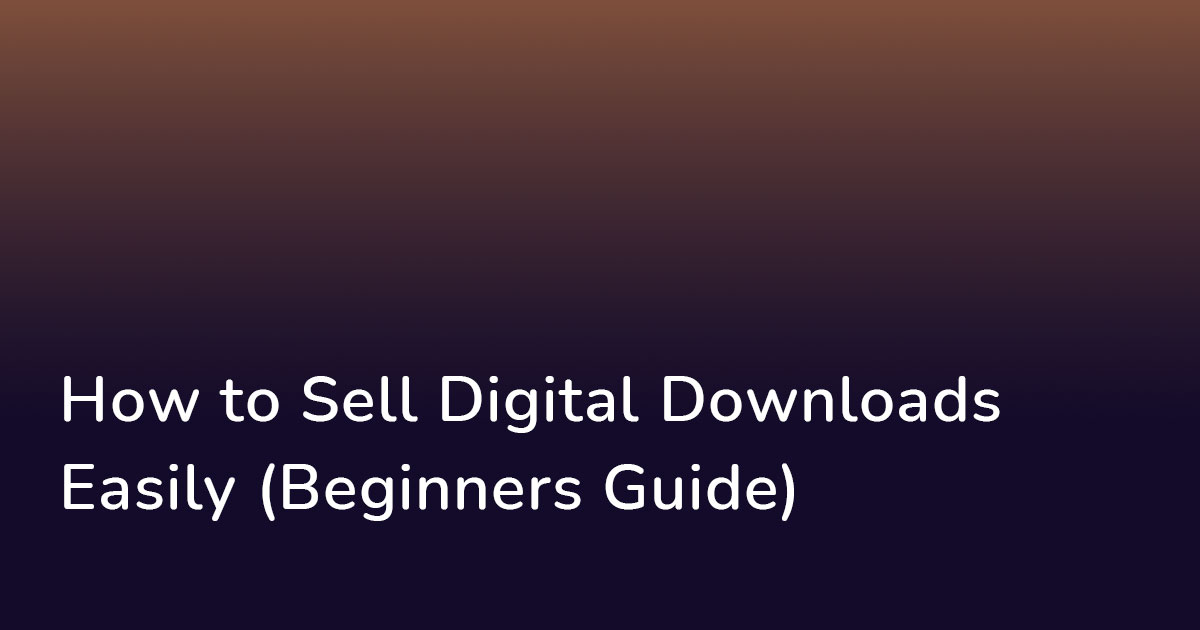
How to Sell Digital Downloads Easily (Beginners Guide)
Thinking about selling digital downloads? You should give it a try.
Selling digital products is one of the best ways to make money online. It can even turn into a source of passive income. And the best part—you don’t need to feel overwhelmed if you’re just starting out.
This guide walks you through everything step by step. From the most popular products to sell, to the best platforms for reaching more customers, you’ll find it all here.
Here’s what you’ll learn:
- What a digital download actually is
- Why it’s worth selling digital products
- The most popular types of downloads to sell
- Where to sell digital downloads
- The best way to market and sell them
- How to sell digital downloads in WordPress
By the end, you’ll have the knowledge and confidence to launch your first digital product and start making sales online.
What is a Digital Download?
A digital download is any type of file you can purchase, access, or transfer online and save directly to your device. Instead of buying a physical product—like a CD, DVD, or printed book—you receive the content instantly in a digital format.
For example, when you buy an eBook, download a music album, or install software from the internet, you’re using a digital download. These files can be stored on your computer, smartphone, or tablet and accessed anytime without the need for physical media.
Why It’s Worth Selling Digital Products?
Selling digital products isn’t just a trend—it’s one of the smartest ways to build a profitable, scalable, and flexible online business. Compared to physical products, digital items offer higher margins, fewer headaches, and unlimited earning potential.
Let’s break down exactly why digital products are worth selling in today’s market.
1. Low Costs, High Profits
One of the biggest advantages of digital products is their affordability.
- No manufacturing expenses: You don’t need raw materials, factories, or warehouses.
- No shipping or packaging: Customers download instantly, which saves you money and time.
- High profit margins: Once your product is created, most of the revenue goes straight into your pocket.
2. Unlimited Scalability
Digital products can be sold endlessly without extra effort.
- No stock limits: Unlike physical goods, digital items never run out.
- Serve global audiences: You can sell to thousands of customers at once, across multiple time zones.
- No extra production cost per sale: Whether you sell 10 copies or 10,000, your costs stay the same.
3. Passive Income Potential
With digital products, you put in the work once and get paid over and over again.
- Automated sales systems: Customers can purchase and download without your direct involvement.
- Evergreen income: Products like eBooks, templates, and online courses can earn money for years.
- Minimal maintenance: With occasional updates, your products can remain profitable long-term.
4. Global Reach & Instant Delivery
The internet removes all geographic barriers.
- Sell anywhere, anytime: Your store is open 24/7, serving customers worldwide.
- Instant access for buyers: No waiting for shipping—customers get their purchase immediately.
- Better customer experience: Fast delivery increases satisfaction and encourages repeat sales.
5. Flexibility & Freedom
Digital products give entrepreneurs the freedom that physical businesses can’t match.
- Work from anywhere: Run your business with just a laptop and Wi-Fi.
- Diverse formats: Sell eBooks, courses, software, designs, music, or templates.
- Creative opportunities: Experiment with bundles, memberships, or freebies to grow your audience.
6. Brand Authority & Trust
Selling digital products also positions you as an expert.
- Build authority: High-quality digital content demonstrates your knowledge and skills.
- Create loyal customers: Satisfied buyers are more likely to return for future products.
- Expand your influence: Over time, you can grow from selling products to offering memberships, premium services, or coaching.
The Most Popular Types of Downloads to Sell
If you want to start selling digital products, the first step is choosing the right type of download. The best products are those people already want—something that saves time, teaches a skill, or provides entertainment.
Here’s a breakdown of the most popular digital downloads to sell online right now.
1) Ebooks
Ebooks are still one of the top-selling digital products. They’re perfect for guides, tutorials, or niche topics where you can share expertise. Formats like PDF, EPUB, or Kindle make them easy to sell and consume.
2) Online Courses & Workshops
Video courses, masterclasses, or step-by-step tutorials are booming. People are always willing to pay for knowledge, whether it’s business training, creative skills, or personal development.
3) Templates & Printables
Planners, resumes, spreadsheets, and checklists are in constant demand. Customers love ready-to-use tools they can download instantly. This category is especially popular on Etsy, Gumroad, and Creative Market.
4) Digital Art & Graphics
Designers can sell illustrations, fonts, icons, or Photoshop files. Businesses, content creators, and bloggers are always looking for fresh visuals.
5) Stock Photography & Video
High-quality images and footage are essential for marketing, websites, and ads. Niche stock libraries—like fitness, food, or travel—often sell faster than generic images.
6) Music & Audio Files
Podcasters, YouTubers, and game developers constantly need background music, jingles, and sound effects. Selling audio files is a great way for musicians and sound engineers to build passive income.
7) Apps & Plugins
If you’re a developer, software solutions, browser extensions, or WordPress plugins can generate long-term income. These products often sell well because they solve specific problems.
Overall, the most profitable digital products depend on your skills and the people you want to reach. Choose a product, topic, or niche that excites you. When you’re passionate about what you’re creating, it’s easier to deliver real value to your audience.
You should also think about market demand and competition. Look at how similar products are priced and how others market them. This will help you find the right strategy to connect with your ideal customers.
Where to Sell Digital Downloads
After deciding what product you want to sell, the next step is figuring out where to sell your digital downloads.
There are three main options:
- A self-hosted WordPress site.
- An online marketplace, where you get a ready-made storefront.
- A pay-as-you-go service provider, often called a SaaS platform.
1) A Self-Hosted WordPress Site
The best place to sell digital downloads is your own website.
Setting up an eCommerce site takes more time than posting on a marketplace. But the extra effort is worth it.
With a self-hosted WordPress site, you can sell directly to your customers. You’ll have more control and flexibility. It’s simple to set up, affordable, and easy to manage.
Pros of Self-Hosted WordPress Site
- You have complete control over design, functionality, and branding.
- Easy to expand as your business grows.
- Thousands of plugins and themes to help you build exactly what you need.
- No commission fees per sale, unlike marketplaces that take a cut.
- You keep more revenue since there are no middlemen.
- Add as many products as you want without marketplace limits.
- SEO benefits to drive organic traffic.
- Accept different payment gateways like PayPal, Stripe, or direct bank transfers.
- Combine your store with a blog, portfolio, or membership site.
Cons of Self-Hosted WordPress Site
- You need to buy hosting, a domain, and install WordPress.
- Unless you choose a managed host, regular updates, backups, and security checks are your responsibility.
- Traffic doesn’t come automatically. You must drive visitors through SEO, ads, or social media.
2) Online Marketplaces
Another option is to use an online marketplace. Some popular platforms for selling digital products are Etsy, Amazon, and Creative Market.
Marketplaces are appealing because they’re simple to join. You don’t need much time to set things up. They also come with built-in traffic and an existing customer base. This can give your product more visibility, although there’s no guarantee of sales.
The downside is the fees. Platforms like Etsy take a cut of every sale. The more you earn, the bigger the share they keep.
Pros of Online Marketplaces
- Built-in traffic, saving you from starting at zero.
- Listing products is simple. You don’t need much tech knowledge to get started.
- Buyers often trust well-known platforms more than unfamiliar websites.
- These platforms often attract international buyers, expanding your audience.
- Most platforms don’t require heavy setup costs. You pay as you sell.
Cons of Online Marketplaces
- Transaction fees, listing fees, and commission cuts can eat into profits.
- Must follow their terms of use, which can change at any time.
- Limited options when it comes to customization and branding.
- Shoppers remember the marketplace, not your brand.
- Hard to collect emails or build a direct relationship with buyers.
- Competing sellers may force you to lower prices to stay relevant.
- If the marketplace changes algorithms, your sales can drop overnight.
3) SaaS Platforms
Another option is to sell your downloads through a Software-as-a-Service (SaaS) platform. Some popular choices are Shopify, Sellfy, and BigCommerce.
These hosted platforms are often easier to set up than building a new WordPress site, though not always. The big advantage is that they usually give you more flexibility and come with fewer drawbacks compared to online marketplaces.
Pros of SaaS Platforms
- Quick and easy setup.
- All-in-one solution for hosting, security, and payment processing.
- Built-in integration for email marketing, analytics, and CRM tools.
- Most SaaS providers offer dedicated support channels.
- More customization options than with marketplaces.
- Usually have a range of pricing options available.
Cons of SaaS Platforms
- Monthly or transaction fees can add up over time.
- You’re often restricted to templates and preset features.
- If the platform shuts down or changes policies, your store is affected.
- Advanced features often require higher-tier (more expensive) plans.
- If the platform goes down, your store is offline too.
- Hard to migrate your business if you outgrow the platform.
The Best Way to Market and Sell Them
Out of the three options, the best way to sell downloads is through your own website. A self-hosted WordPress site works perfectly for this.
WordPress is the most popular CMS in the world. It powers more than 43% of all websites online. It also has the biggest library of plugins and themes you’ll find anywhere.
The software itself is free. All you need is hosting, a domain name, and an eCommerce plugin.
If you’re on a budget and looking for cheap WordPress hosting, start with Bluehost or Hostinger. Both are affordable and include everything you need to launch an online store.
For selling digital downloads, the best WordPress plugin is Easy Digital Downloads (EDD). With EDD, you can sell ebooks, PDFs, WordPress plugins, or almost any other digital file.
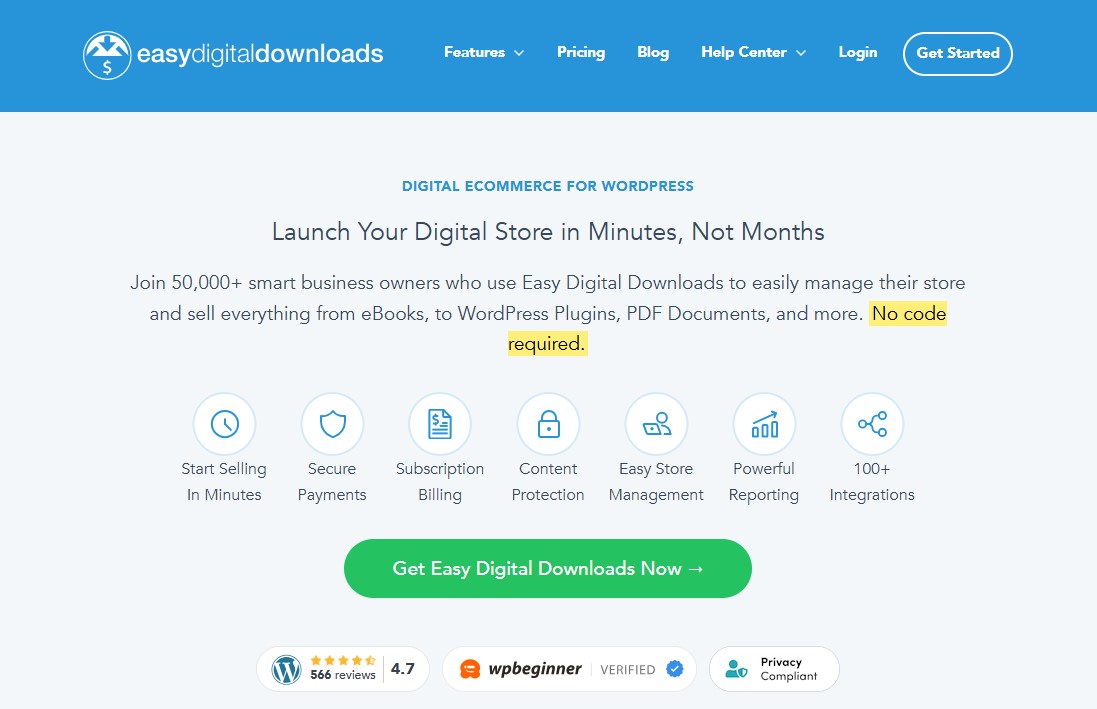
The best part? The core EDD plugin is completely free.
- Unlimited digital products
- Full control over pricing
- Shopping cart
- Flexible checkout options
- Discount codes
- eCommerce reports
- Stripe or PayPal integration
- And more
Additionally, you can grow your store’s functionality over time by upgrading to an EDD Pro plan. With Pro, you’ll be able to accept recurring payments for memberships and subscriptions. It also connects with premium marketing and optimization tools. Plus, you get built-in features for upselling and cross-selling.
Start with Easy Digital Downloads
How to Sell Digital Downloads in WordPress With EDD
If you’re already a WordPress user, follow the step-by-step guide below to learn how to sell digital downloads with EDD.
1. Install Easy Digital Downloads
To install and activate the EDD plugin, simply go to the WordPress dashboard, then go to Plugins » Add Plugin. From here, search for the core plugin in the repository.
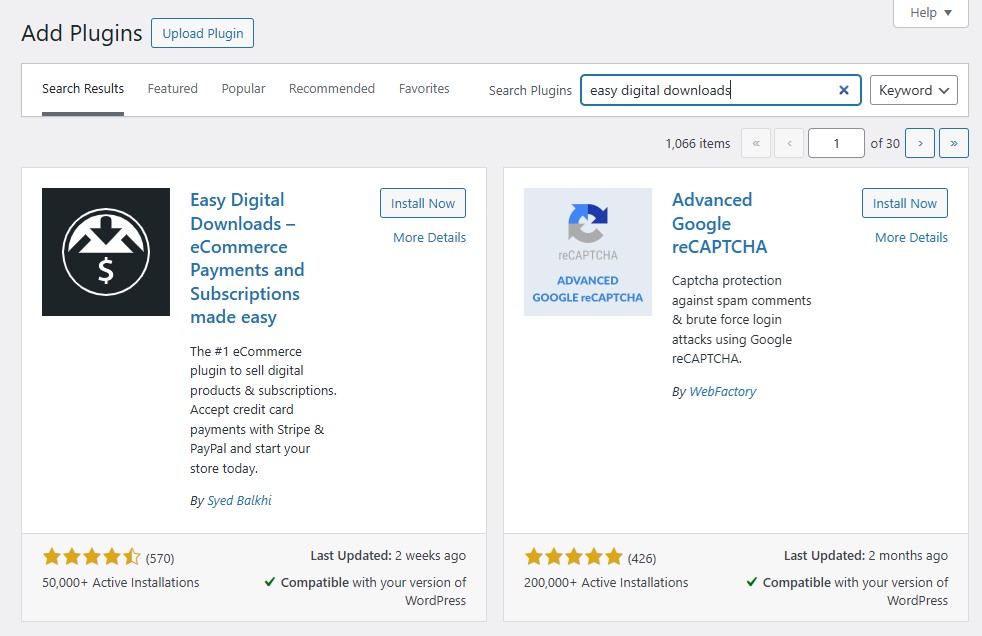
If you have a pro version, simply click on the Upload Plugin button at the top, choose the downloaded plugin zip file, and click on the Install Now button, followed by Activate Plugin.

Once it’s activated, you will see a new Downloads menu item in your WordPress dashboard.
You can click on Get Started to launch the Onboarding Wizard.
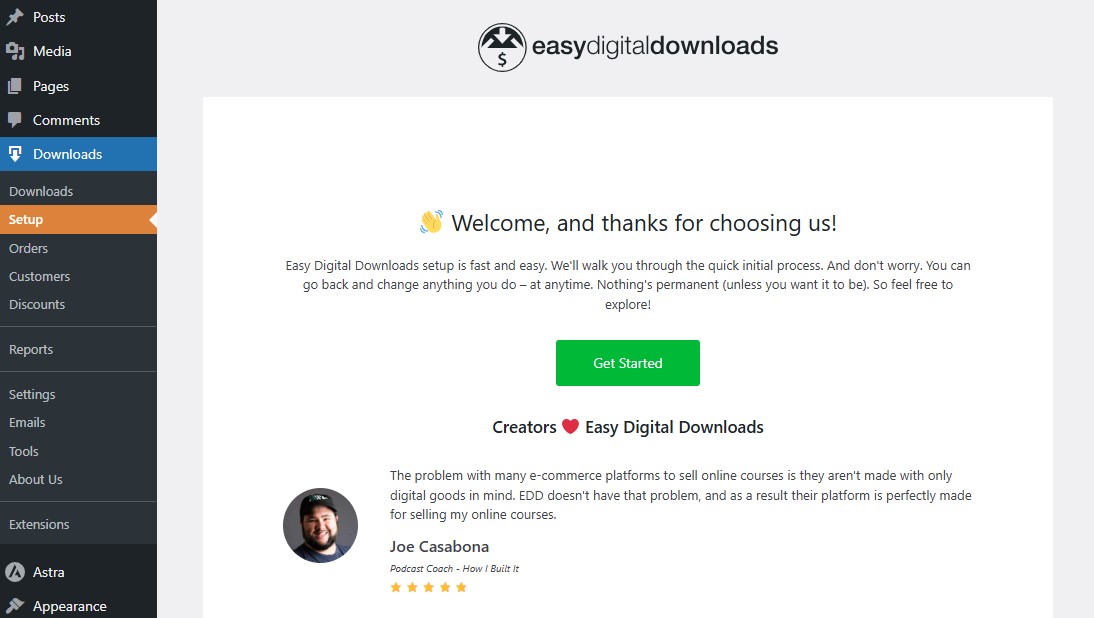
The setup wizard guides you through the initial steps of starting your store. Connect Stripe, choose optimization tools, and add your first product.
2. Setting Up Your Payment Gateway
If you want to turn your WordPress site into an online store, you’ll need a way to accept payments. Easy Digital Downloads makes this simple by supporting several gateways, including PayPal, Stripe, and Authorize.net.
We recommend using Stripe. It gives your customers multiple payment options and removes the extra transaction fees you’d normally pay with the standard Stripe setup.
To connect Stripe, go to Downloads » Settings » Payments in your WordPress dashboard. From there, set Stripe as your default payment gateway. Under the Stripe tab, click Connect with Stripe.
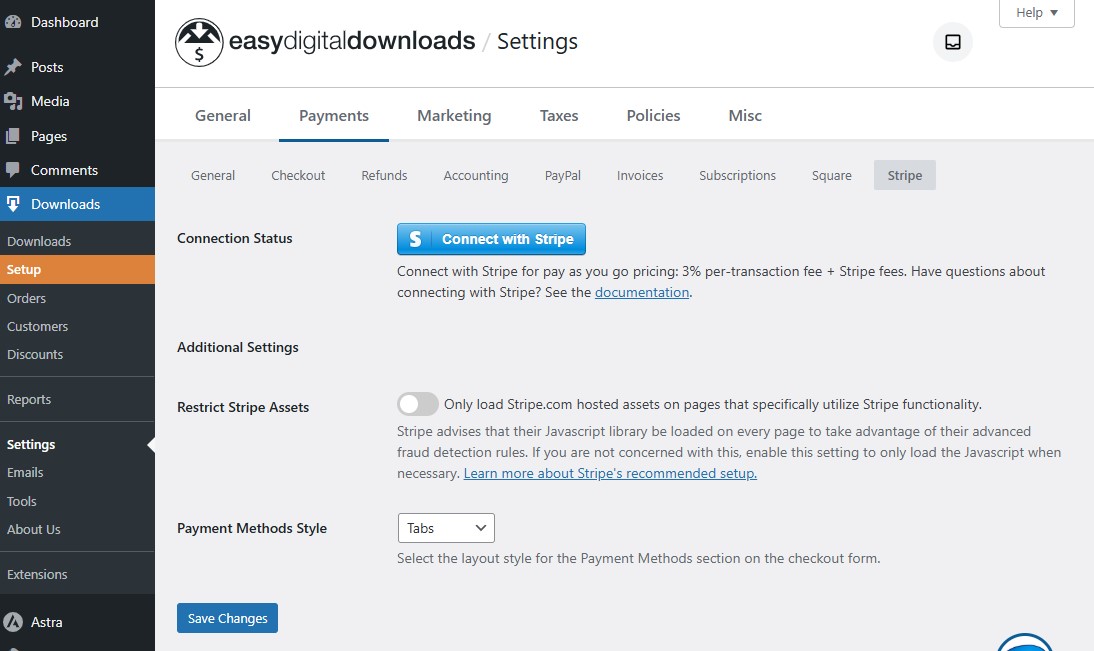
Log in with your Stripe credentials. If you don’t have an account yet, you can create one for free. After logging in, choose your account and click Connect to link it with Easy Digital Downloads.

You’ll also need to set up webhooks to finish the connection. Once everything is configured, you can enable the payment methods you want.

The payment options available will depend on factors like your country and Stripe plan.
3. Add Your Digital Products
Once your store is connected to a payment gateway, you’re ready to start adding products. In Easy Digital Downloads, all digital items are called “downloads.” To create one, go to Downloads » Downloads and click on the Add Download button at the top.

Give your product a name, then add a description. Use the description to explain what the product is, how it’s used, and any important technical details.

Next, set the price. Under the Details tab, enter the amount you want to charge.

Now it’s time to upload the file. In the Files tab, click the link icon under File URL. Upload the file from your computer. After that, you can edit the File Name. This is the text your customers will see and click to download their purchase, so make sure it’s clear.

On the right side, you’ll see the option to set the download image. This image will show up on your shop and product pages.
When everything looks good, click Publish to make the product live. You can then select View Download to preview how the product page appears on your site.
Repeat this process for each product you want to add.
4. Customize Your Shop & Checkout Pages
Easy Digital Downloads makes it easy to customize your site. You can edit how your checkout, shop, and product pages look.
When you install EDD, it automatically creates a checkout page for you.
You can edit the checkout address fields and other options by going to Downloads » Settings » Payments » Checkout.
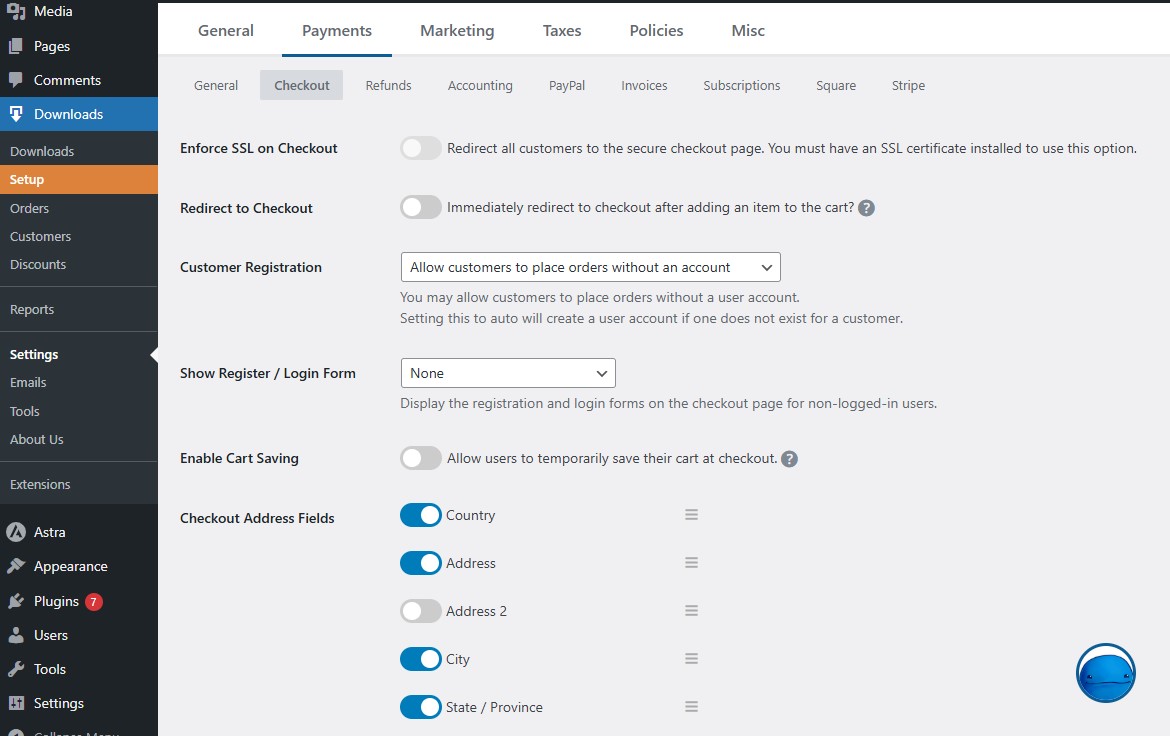
The Shop page uses the EDD Products block to display your items. On the right-hand panel, you’ll find settings to tweak the layout. For example, you can change how many downloads show per page and how many columns appear.
Each product also has its own settings. You can control the featured image position, show or hide the title, adjust image size, alignment, and more.
Once you’re finished, don’t forget to save your changes.
5. Promoting Your Digital Products
The last step is getting the word out about your store.
There are plenty of ways to do this. A good starting point is your blog. Use it to showcase your products and attract more visitors. To boost your visibility in search engines, check out these blog SEO tips.
Email marketing is another great option. You can use lead magnets to grow your email list and connect with potential customers. EDD makes this easy since it works with many popular email services.
You can also try affiliate marketing to reach a wider audience. This works like a referral program. Bloggers, publishers, brands, and influencers promote your products. In return, they earn a commission for every customer they send your way.
Final Thoughts: Start Selling Digital Downloads Today
Selling digital downloads is one of the simplest ways to start an online business. It’s affordable, hassle-free, and gives you access to customers all over the world. That’s why it works well for both beginners and experienced entrepreneurs.
You can sell almost anything—ebooks, templates, music, or software. The key is to offer something that solves a problem or provides real value. Once you’ve chosen your product, pick a platform that gives you control and room to grow. A great option is a WordPress site with Easy Digital Downloads.
Next, focus on promotion. Blogging, email marketing, and affiliate partnerships are all proven ways to get more sales.
The best part? Getting started doesn’t take long. Once your first product is live, your store runs around the clock, ready to serve buyers everywhere.
So don’t put it off. Launch your digital download store with Easy Digital Downloads today and start building a business that works for you.
Start With Easy Digital Downloads
For more, check out these other helpful resources:
- Best Shopify Alternatives – Top 11 Picks
- 10 Best Gumroad Alternatives for Creators & Sellers
- How to Start an Online Store (Beginners Guide)
Lastly, follow us on Facebook and X (formerly Twitter) to stay updated on the latest WordPress and blogging-related articles.